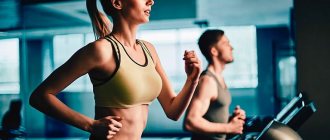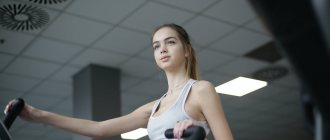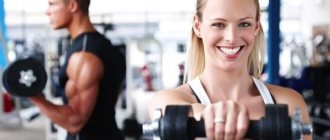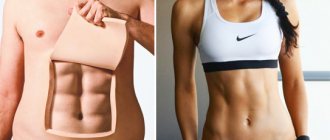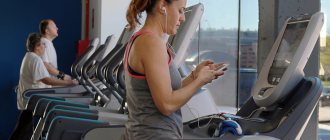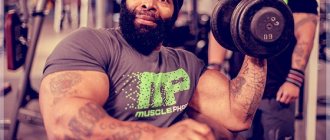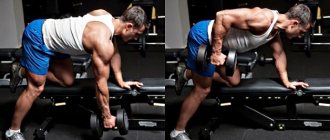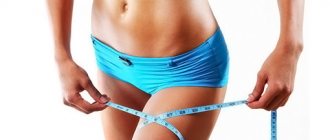Proper training on an exercise bike is the key to success
Regular aerobic exercise allows the body to become more resilient, oxygenate with maximum efficiency and make the respiratory and cardiovascular systems stronger. In addition, cardio exercises, which include cycling, are effective for losing excess weight. Such versatility of cycling loads makes training on a cycling trainer popular not only as an exercise in the gym, but also in the form of home independent training.
It should be understood that training on an exercise bike is not a way to build muscles or achieve the desired relief for many. This simulator is ideal for really taking care of your health, for strengthening blood vessels and the heart, and for increasing body tone.
Despite all its apparent safety, an exercise bike should not be used haphazardly, since even such a simple device can be harmful to health if used improperly. First of all, it is important to remember the contraindications : hypertension, angina pectoris, tachycardia, heart disease and vascular disease - all these problems are a good reason to abandon such activities in favor of more gentle ones.
It is also undesirable to resort to such training in a weakened state: during colds and flu or after an illness.
Why do you need an exercise bike?
Cycling and regular cardio exercises have a complex effect on the body. They reduce the risk of developing cardiovascular diseases, strengthen muscles and joints, and burn fat deposits. The cardio exercise bike has gained particular popularity in recent years. It is a unique bicycle that, under certain loads, helps strengthen the muscles of the back, hips, abs, and legs.
Cardio training, called “cycle,” has become popular in modern fitness. The instructor controls the load, speed, physical condition of the person, and provides psychological assistance. Exercises perfectly train the cardiovascular and respiratory systems, help tighten the legs and buttocks. Regular cycling helps you get rid of extra calories, lose weight and always be in good shape.
Typical training schemes on an exercise bike
Fitness experts identify several basic programs for exercise on an exercise bike that are suitable for most exercisers:
- The scheme for beginners is a starting point for unprepared people. It involves gradually increasing the load and increasing the duration of classes to half an hour a day, at least 4 times a week. At this level, it is important not to increase, but to maintain the given intensity: it is important to do not stronger, but longer.
FACT! Typically, the scheme for beginners is used during the first two months of training, which allows the body to be maximally prepared for more significant loads.
- The next stage of training and the next scheme is an intermediate program for one and a half to two months of more intense training for 45 minutes, at least five times a week. At this stage, the effect of weight loss or muscle development becomes noticeable; trainees note a significant increase in performance and ease during exercise.
ADVICE! It is important to remember that the effectiveness of exercise on an exercise bike for losing excess weight depends on the heart rate: maximum performance is observed only at 70% of the maximum for a particular age.
- The program for athletes is a maximum load that is only available to fully trained people. It involves daily classes lasting at least an hour. It is not advisable to resort to such a scheme on your own: such a significant load is suitable only for people with sufficient physical fitness.
- What's happened
mini exercise bike
- and how to use it.
Workout program for weight loss
Before you start training on an exercise bike for weight loss, the system of which may be different, do a warm-up. This could be jumping, bending, squats, push-ups, and so on. This will help prevent sprains, warm up the muscles and prepare them for stress. This way, warming up will help you burn more calories during your workout.
There are several training programs. They differ in intensity depending on the initial level of training. Their essence is to increase the load over time and lose weight without harming the body.
Program for beginners
With an activity such as an exercise bike for weight loss, the training program for women and men who are beginners is designed for 6-8 weeks. She offers classes in the following mode:
- You need to exercise 3-4 times a week;
- The duration of the lesson is half an hour, excluding warm-up.
- The pulse should be 60-70% of the maximum;
- The frequency of steps should not exceed 50 per minute.
Program for losing weight and maintaining results
The most active phase of exercise, which helps to get rid of excess weight. It will help you to use it not only for such a task as how to properly train on an exercise bike to lose weight, but also for maintaining physical fitness. Its duration will be individual, since the rate of weight loss is determined by the characteristics of a particular organism.
- You need to exercise 4-5 times a week.
- The duration of the lesson is 45 minutes.
- The pulse can be 70-80% of the maximum for age.
- The frequency of steps is 50-60 per minute.
Senior program
An exercise bike can be very useful for older people who want to stay in shape. Classes are indicated for problems with the back, bones, and legs. They will help reduce pain in joint diseases and will be an effective prevention of thrombosis, stroke, diabetes, obesity, and Alzheimer's disease.
Older people need to exercise in a way that is comfortable for them. Start with minimal intensity and increase the load over time. It is important that the norm is determined by a specialist, taking into account the state of health and the individual characteristics of the body. Elderly people should exercise under the supervision of a trainer no more than 40 minutes a day . It is important to drink enough liquid.
Find out more about the benefits of an exercise bike for health and the weight loss process in general: https://www.fitnessera.ru/polza-i-vred-velotrenazhera-chto-daet-velotrenazher-kakie-myshcy-treniruet-skolko-kalorij-szhigaet.html
What to consider when using an exercise bike
A few seemingly insignificant, but extremely important for getting a good result, little things can make training on the simulator as effective as possible. In the process of working with an exercise bike, nothing is unimportant, since even an incorrect position on the bike can make training not only useless, but also harmful for the exerciser.
- Position on an exercise bike . An uncomfortable position on an exercise bike can lead not only to fatigue, but also to chronic pain. Unlike the usual bent position, which is considered ideal for cyclists, you should sit upright . At the same time, it is important to correctly adjust the seat height and hold the steering wheel: the correct position and load distribution will help you endure long workouts more calmly.
- Apprentice's clothing . Of course, you shouldn’t buy expensive cycling equipment: just comfortable sportswear that won’t hinder your movement and make it difficult to pedal.
ADVICE! If changing shoes is mandatory for working out in the gym, then at home many people neglect them and try to exercise barefoot or in socks. But this option is unacceptable for an exercise bike: you need to use sneakers or light sneakers.
- Correct goal setting and competent assessment of your condition. Before starting training, it is important not only to get an idea of your physical fitness and formulate goals, but also to determine the end result. To lose weight, you need training of one intensity, to work out muscles - another, to prepare for the cycling season - a third. Any deviations from the normal state during training should be a signal to stop training and find out the reasons: pain, nausea, weakness, shortness of breath, etc. are not the norm for such training.
ADVICE! Experts recommend choosing the time for classes based on the biorhythm of a particular person: if late classes are suitable for an “owl,” then it is advisable to send a “lark” to the gym in the morning.
- Compliance with general standards of behavior on simulators . You cannot start and end a workout too abruptly: it is imperative to do a minimum warm-up for the joints and all muscle groups - everyone should remember these simple truths. Only the right approach to the preparatory process before a lesson will make the training itself effective.
For many, exercise on an exercise bike is a life-saving option in the absence of proper physical activity - with a sedentary lifestyle or office work. An exercise bike, as a classic cardio workout, is ideal for people of any age and health group, which makes it incredibly popular among all segments of the population.
- Is it possible to lose weight using an exercise bike? Exercises on an exercise bike for weight loss (exercises).
- How many calories are burned on a bicycle and exercise bike? To know…
- What are the benefits of an exercise bike, what muscles work (swing), benefits and harms for men and women. www.velosipedinfo.ru/polza-ot-ezdyi-na-velotrenazhere-i-velosipede
- How to make an exercise bike out of a bicycle with your own hands.
Video. Exercise bike workout
The author of the article is Lyudmila Tikhomirova [Mil0chka]
How to improve your results: additional tips
An exercise bike, how to exercise correctly in order to lose weight, with the help of which, you can already roughly imagine, will become even more effective if you follow additional recommendations. They will be as follows:
- Please note that no amount of training will give the desired result if you eat incorrectly. Therefore, those who want to lose weight should pay attention to their diet. It is advisable to calculate it so that you consume fewer calories than you burn in a day. In addition, try to exclude fast food, flour, sweets, and fatty foods from your diet. Foods that promote weight loss are cereals, lean meats, dairy products, and fresh fruits and vegetables. You need to try to build your diet around them.
- It is important to maintain a drinking regime. An adult needs at least 1.5-2 liters of water per day. We are talking about pure still water without foreign impurities.
- Exercise on an exercise bike can be combined or alternated with other types of activity. Running, jumping rope, elliptical trainers - all this will help increase your effectiveness in losing weight. If you want to not only lose fat, but also build muscle, pay attention to weight training equipment.
- Pay attention to what you're doing. Expensive specialized equipment is unnecessary, but your clothes should be comfortable for you to exercise. It should not restrict movement. In addition, it is important to exercise in comfortable sneakers or sneakers. Do not do this barefoot or in socks.
- When sitting on the exercise machine, pay attention to your posture. If on a regular bicycle the back position is usually half-bent, then when exercising on an exercise bike you need to keep your back straight. This will help strengthen your muscles and improve your posture.
- Before training, you should not eat heavily, otherwise your body will spend energy not on burning fat, but on digesting what you eat. It is better to exercise no earlier than an hour after eating.
- Do not stop your workout abruptly to avoid overloading your cardiovascular system. Reduce your speed gradually, pedaling until you feel your heart rate and breathing have returned.
- Your workout will become more enjoyable and seem faster if you listen to your favorite music or watch something interesting on TV. This technique can be used by those who find exercise on an exercise bike boring and monotonous.
Take the traffic rules knowledge test for a cyclist!
Time limit: 0
Navigation (job numbers only)
0 out of 15 tasks completed
Questions:
- 1
- 2
- 3
- 4
- 5
- 6
- 7
- 8
- 9
- 10
- 11
- 12
- 13
- 14
- 15
Information
To be able to obtain rights, please click Next
You have already taken the test before. You can't start it again.
The test is loading...
You must log in or register in order to begin the test.
You must complete the following tests to start this one:
results
Correct answers: 0 out of 15
Your time:
Time is over
You scored 0 out of 0 points (0)
Categories
- No category 0%
- Please write in the comments if you liked the test.
Should things like this be added to the site? What would you like to see on the site? Thanks in advance for your feedback!
maximum of 15 points
| Place | Name | Recorded | Points | Result |
| Table is loading | ||||
| No data | ||||
Your result has been recorded in the leaderboard Loading
- 1
- 2
- 3
- 4
- 5
- 6
- 7
- 8
- 9
- 10
- 11
- 12
- 13
- 14
- 15
- With answer
- With a viewing mark
- Task 1 of 15
1.
Exercise bike - how to exercise correctly to lose weight?
Video on the topic
If you want to start training, choose an effective method for losing weight and learn more about it. We hope that the information provided in this material will also be of some benefit to you.
Since the muscles of the lower extremities have a large mass, when training them, a lot of energy is expended and more calories are burned.
In order to set the right bar for yourself, you need to know how much time you need to devote to classes to achieve results. To calculate how much time you need to train, you need to conduct your own observations of your health and well-being.
Note!
Of course, it is better to do this under the guidance of an experienced fitness instructor, especially in the initial stages, but if you work out on your own, built-in programs with a training diary can be a good alternative to instructors. It shows important indicators: the number of calories burned, heart rate and others.
You can calculate the approximate calorie consumption when exercising on an exercise bike using our calculator.
Even the most ordinary exercise bike, which has a minimal set of functions, makes it possible to exercise effectively. With it you can: 1) Speed up the metabolic process. Due to the fact that metabolism accelerates, calorie consumption increases, and this leads to weight loss.2) Strengthen the cardiovascular system and normalize blood pressure.
2) Correct your figure and lose excess weight. Exercises help strengthen the muscles of the legs and buttocks, and help burn belly fat. If you do regular workouts and eat a balanced diet, your body will soon become fit and slender.
Duration of classes keeping the body in good shape - training time is about 20 minutes daily; for quick weight loss, duration of classes is at least 45 minutes, frequency of classes: 3-5 times a week;
Cardio training, ideally 60-80 minutes. Frequency of classes: 3 times a week.
In order to achieve good results, you do not need to travel too long distances. Overload will not bring any benefit, but rather harm your health. It is necessary to start with small temporary indicators, gradually increasing the load.
For the first lessons, a healthy person only needs to drive for a maximum of 10-15 minutes. In the initial stages, training 3 times a week is enough.
When you feel that you can easily cope with this load during training, you can increase the time to 30, 45, if you feel well - 60-80 minutes.
After 2-3 months, the number of workouts can be increased to five times a week.
1) For a good mood, you can turn on music. 2) During training, your mouth often gets dry. Therefore, there should be a bottle of water next to you. 3) Before starting classes, you need to do a short warm-up and warm up your muscles a little. Otherwise you may get injured. Warm-up includes simple exercises for the feet, hips, shoulder girdle and lower legs.
4) After training, you can eat no less than an hour later.
Average speed indicators The optimal “driving” speed is 15-30 km/h. It is important to pay attention to the pulse; the heart rate during training is in the range of 120-150 beats per minute. If at this speed the pulse is less than 120 beats per minute, you can increase the speed, and if it is more than 150 beats per minute. - Slow down or take a short break.
Are the Rules broken in the situations depicted?
Correct 6. Requirements for cyclists
6.6. A cyclist is prohibited from:
d) while driving, hold on to another vehicle;
f) tow bicycles;
Wrong 6. Requirements for cyclists
6.6. A cyclist is prohibited from:
d) while driving, hold on to another vehicle;
f) tow bicycles;
2.
Which cyclist doesn't break the rules?
Correct 6. Requirements for cyclists
6.6. A cyclist is prohibited from:
b) move on highways and roads for cars, as well as on the roadway if there is a bicycle path nearby;
Wrong 6. Requirements for cyclists
6.6. A cyclist is prohibited from:
b) move on highways and roads for cars, as well as on the roadway if there is a bicycle path nearby;
3.
Results from cycling training
The main effectiveness of cycling is that calories are burned very quickly - up to 800 kcal in one session. Sweating also releases toxins, so be sure to drink water before your workout. If you regularly visit the gym (which is 2-3 times a week), within a month you will see the first positive results: a beautiful belly, toned buttocks. You will no longer be afraid of climbing stairs, long walks, or hikes, because your respiratory system will be perfectly trained. The main thing is to remember to control yourself when eating and then the excess weight will quickly go away.
Who should give way?
Correct 6. Requirements for cyclists
6.5. If a bicycle lane crosses a road outside an intersection, cyclists must give way to other vehicles traveling on the road.
Wrong 6. Requirements for cyclists
6.5. If a bicycle lane crosses a road outside an intersection, cyclists must give way to other vehicles traveling on the road.
4.
What loads is a cyclist allowed to carry?
Correct 6. Requirements for cyclists
6.4. A cyclist may only carry such loads that do not interfere with the operation of the bicycle and do not create obstacles for other road users.
22. Cargo transportation
22.3. Transportation of cargo is permitted provided that it:
b) does not interfere with the stability of the vehicle and does not complicate its control;
Wrong 6. Requirements for cyclists
6.4. A cyclist may only carry such loads that do not interfere with the operation of the bicycle and do not create obstacles for other road users.
22. Cargo transportation
22.3. Transportation of cargo is permitted provided that it:
b) does not interfere with the stability of the vehicle and does not complicate its control;
5.
Rules for training on an exercise bike
What would seem to be the rules - sit down and pedal, make a slim figure! But training on an exercise bike “to suit your mood” brings much less benefit than systematic exercise.
The following parameters are important for this:
- body position and execution technique;
- load range and optimal heart rate;
- cloth;
- parameter monitoring;
- compliance with fitness rules.
Technique and body position
These two parameters are important for a productive workout on an exercise bike. There is no need, as beginners do, to bend too much in the lower back - the back is kept relaxed and in a natural position. It is allowed to round the shoulders.
Hands relaxed:
they do not bear the main weight. To ensure uniform muscle load, the knees are directed forward and slightly inward. Feet are parallel to the floor. They hold their head as if they were riding a “real” bicycle: you need to look straight, keeping your head level. The seat needs to be adjusted.
Optimal load range
Only if training on an exercise bike will benefit the body if the range of loads corresponds to the physical fitness of the athlete
To do this, it is important to monitor your health and measure your pulse. For those who train to lose weight, it is important to carry out exercises with medium intensity: the pedals rotate easily for 30 minutes (this is the only way to start the fat burning process)
If the load is increased, the training time is reduced.
Before you start training on an exercise bike, you need to find out several parameters: maximum heart rate and optimal heart rate zone. This will make fat burning and figure shaping activities productive.
Monitoring indicators
Experts advise constantly monitoring while training on an exercise bike: heart rate, distance traveled, number of calories burned and other indicators provided by the machine’s computer. Record data in a log. This will help you achieve the highest productivity in your classes and clearly evaluate the results.
Cloth
The ideal clothes for training on a stationary bike are a tank top and cycling shorts, which do not interfere with movement and make it easier to sit on. Shoes should have hard soles to better secure your feet on the pedals. Sneakers and sneakers are suitable, but not Czech shoes or slippers. It is appropriate to wear special gloves for contact with the steering wheel.
Rules
Rules known to everyone, but which, nevertheless, are sometimes forgotten:
- You need to breathe only through your nose, making sure that your breathing is even;
- do not forget about the warm-up, warming up before the load: ligaments, muscles, joints;
- do not abruptly interrupt the training - do a “cool-down”, which will help the heart move from high-frequency contractions to low ones;
- Do not exercise if you feel weak or unwell.
The level of load and duration of training on an exercise bike should correspond to the final goals and physical capabilities. To lose weight, exercise time on the simulator is at least 40 minutes. To prevent classes from seeming boring, do them with music.
Which cyclists violate the Rules when transporting passengers?
Correct 6. Requirements for cyclists
6.6. A cyclist is prohibited from:
e) carry passengers on a bicycle (except for children under 7 years old, transported on an additional seat equipped with securely fastened footrests);
Wrong 6. Requirements for cyclists
6.6. A cyclist is prohibited from:
e) carry passengers on a bicycle (except for children under 7 years old, transported on an additional seat equipped with securely fastened footrests);
6.
In what order will vehicles pass through the intersection?
Correct 16. Driving through intersections
16.11. At an intersection of unequal roads, the driver of a vehicle moving on a secondary road must give way to vehicles approaching this intersection of carriageways on the main road, regardless of the direction of their further movement.
16.12. At the intersection of equivalent roads, the driver of a non-rail vehicle is obliged to give way to vehicles approaching from the right. Tram drivers should follow this rule among themselves. At any unregulated intersection, a tram, regardless of the direction of its further movement, has an advantage over non-rail vehicles approaching it along an equivalent road.
16.14. If the main road at an intersection changes direction, drivers of vehicles moving along it must follow the rules for driving through intersections of equivalent roads. This rule should be followed among themselves and by drivers driving on secondary roads.
Wrong 16. Driving through intersections
16.11. At an intersection of unequal roads, the driver of a vehicle moving on a secondary road must give way to vehicles approaching this intersection of carriageways on the main road, regardless of the direction of their further movement.
16.12. At the intersection of equivalent roads, the driver of a non-rail vehicle is obliged to give way to vehicles approaching from the right. Tram drivers should follow this rule among themselves. At any unregulated intersection, a tram, regardless of the direction of its further movement, has an advantage over non-rail vehicles approaching it along an equivalent road.
16.14. If the main road at an intersection changes direction, drivers of vehicles moving along it must follow the rules for driving through intersections of equivalent roads. This rule should be followed among themselves and by drivers driving on secondary roads.
7.
Riding bicycles on sidewalks and pedestrian paths:
Correct 6. Requirements for cyclists
6.6. A cyclist is prohibited from:
c) move on sidewalks and pedestrian paths (except for children under 7 years old on children's bicycles under the supervision of adults);
Wrong 6. Requirements for cyclists
6.6. A cyclist is prohibited from:
c) move on sidewalks and pedestrian paths (except for children under 7 years old on children's bicycles under the supervision of adults);
8.
Who has the right of way when crossing a bike path?
Correct 6. Requirements for cyclists
6.5. If a bicycle lane crosses a road outside an intersection, cyclists must give way to other vehicles traveling on the road.
Wrong 6. Requirements for cyclists
6.5. If a bicycle lane crosses a road outside an intersection, cyclists must give way to other vehicles traveling on the road.
9.
What distance should be between groups of cyclists moving in a column?
Correct 6. Requirements for cyclists
6.3. Cyclists traveling in groups must ride one after another so as not to interfere with other road users. A column of cyclists moving along the roadway must be divided into groups (up to 10 cyclists in a group) with a movement distance between groups of 80-100 m.
Wrong 6. Requirements for cyclists
6.3. Cyclists traveling in groups must ride one after another so as not to interfere with other road users. A column of cyclists moving along the roadway must be divided into groups (up to 10 cyclists in a group) with a movement distance between groups of 80-100 m.
10.
Fitness training on an exercise bike
You need to prepare for exercise on an exercise bike: get sports equipment, familiarize yourself with the rules of working on the exercise bike. Clothes for exercise should be comfortable, light, not restrictive, and not too long so as to interfere with pedaling. It is better to wear shorts or cycling leggings, and a sports T-shirt or T-shirt with them. You must train in shoes. This could be special cycling shoes or regular sneakers.
It is very important to learn how to sit correctly on an exercise bike; it determines how comfortable and effective your workouts will be. The landing should be level, relaxed, without strong arching of the back.
The shoulders can be slightly rounded. A mistake is transferring body weight to your arms. The upper limbs should rest freely on the handlebars and remain relaxed - only the lower part of the body should work. Keep your head elevated and your knees pointing forward or inward. The load should fall evenly on the entire foot. If you only press on the pedals with your fingers, you may experience pain and cramps in your legs. And if you lean forward too much, your back may hurt.
Vehicles will pass through the intersection in the following order
Correct 16. Driving through intersections
16.11. At an intersection of unequal roads, the driver of a vehicle moving on a secondary road must give way to vehicles approaching this intersection of carriageways on the main road, regardless of the direction of their further movement.
16.13. Before turning left and making a U-turn, the driver of a non-rail vehicle must give way to a tram in the same direction, as well as to vehicles moving on an equivalent road in the opposite direction straight or to the right.
Wrong 16. Driving through intersections
16.11. At an intersection of unequal roads, the driver of a vehicle moving on a secondary road must give way to vehicles approaching this intersection of carriageways on the main road, regardless of the direction of their further movement.
16.13. Before turning left and making a U-turn, the driver of a non-rail vehicle must give way to a tram in the same direction, as well as to vehicles moving on an equivalent road in the opposite direction straight or to the right.
11.
How to create an individual training program?
In order for a training program on an exercise bike to produce results as quickly as possible, it must be compiled individually for each athlete. When selecting loads, it is important to take into account a person’s lifestyle, physical fitness, expected regularity of training and the presence of health restrictions.
A properly composed complex implies:
- Keeping the athlete's heart rate in the range of 120-140 beats per minute. (otherwise, muscle mass will increase or, conversely, be burned along with fat. In both cases, the appearance of the body will be far from perfect and fit).
- Gradual increase in load (both within one approach and the training scheme as a whole).
- High intensity only if the athlete has no contraindications (in all other cases, moderate or low intensity is recommended, at which the athlete’s breathing does not become interrupted and the heart rate remains stable).
A cyclist passes an intersection:
Correct 8. Traffic regulation
8.3. Traffic controller signals take precedence over traffic light signals and road sign requirements and are mandatory. Traffic lights, other than flashing yellow ones, take precedence over priority road signs. Drivers and pedestrians must comply with the additional requirements of the traffic controller, even if they contradict traffic lights, road signs and markings.
16. Driving through intersections
16.6. When turning left or turning around when the main traffic light is green, the driver of a non-rail vehicle is obliged to give way to a tram in the same direction, as well as to vehicles moving straight in the opposite direction or turning right. Tram drivers should follow this rule among themselves.
Wrong 8. Traffic control
8.3. Traffic controller signals take precedence over traffic light signals and road sign requirements and are mandatory. Traffic lights, other than flashing yellow ones, take precedence over priority road signs. Drivers and pedestrians must comply with the additional requirements of the traffic controller, even if they contradict traffic lights, road signs and markings.
16. Driving through intersections
16.6. When turning left or turning around when the main traffic light is green, the driver of a non-rail vehicle is obliged to give way to a tram in the same direction, as well as to vehicles moving straight in the opposite direction or turning right. Tram drivers should follow this rule among themselves.
12.
Flashing red signals of this traffic light:
Correct 8. Traffic regulation
8.7.6. To regulate traffic at railway crossings, traffic lights with two red signals or one white-lunar and two red ones are used, having the following meanings:
a) flashing red signals prohibit the movement of vehicles through the crossing;
b) a flashing white-lunar signal indicates that the alarm system is working and does not prohibit vehicle movement.
At railway crossings, simultaneously with the prohibitory traffic light signal, an audible signal may be turned on, additionally informing road users that movement through the crossing is prohibited.
Wrong 8. Traffic control
8.7.6. To regulate traffic at railway crossings, traffic lights with two red signals or one white-lunar and two red ones are used, having the following meanings:
a) flashing red signals prohibit the movement of vehicles through the crossing;
b) a flashing white-lunar signal indicates that the alarm system is working and does not prohibit vehicle movement.
At railway crossings, simultaneously with the prohibitory traffic light signal, an audible signal may be turned on, additionally informing road users that movement through the crossing is prohibited.
13.
How to prepare for training
You should choose the optimal time for classes. Focus on the biorhythms of your own body. If you are a morning person, train in the morning; if you are a night owl, choose a time in the 2nd half of the day. You should not sit on the exercise machine earlier than a couple of hours after sleep and later than 2 hours before your night's rest.
After eating, at least 90 minutes should pass before physical activity. Do not smoke, drink coffee, or take medications an hour before training. If you experience dry mouth or thirst during exercise, rinse your mouth or take one sip - large amounts of liquid are not recommended.
Start with a warm-up: it should involve those muscle groups that will work. Do a complex consisting of squats, bends, warming up the muscles and joints of the shoulder girdle. You can massage and rub your knee joints, since they bear the main load while pedaling. Don't forget to stretch the muscles of your lower extremities.
The driver of which vehicle will cross the intersection second?
Correct 16. Driving through intersections
16.11. At an intersection of unequal roads, the driver of a vehicle moving on a secondary road must give way to vehicles approaching this intersection of carriageways on the main road, regardless of the direction of their further movement.
16.14. If the main road at an intersection changes direction, drivers of vehicles moving along it must follow the rules for driving through intersections of equivalent roads.
This rule should be followed among themselves and by drivers driving on secondary roads.
Wrong 16. Driving through intersections
16.11. At an intersection of unequal roads, the driver of a vehicle moving on a secondary road must give way to vehicles approaching this intersection of carriageways on the main road, regardless of the direction of their further movement.
16.14. If the main road at an intersection changes direction, drivers of vehicles moving along it must follow the rules for driving through intersections of equivalent roads.
This rule should be followed among themselves and by drivers driving on secondary roads.
14.
Cyclist:
Correct 8. Traffic regulation
8.7.3. Traffic light signals have the following meanings:
A signal in the form of an arrow that allows a left turn also allows a U-turn if it is not prohibited by road signs.
A signal in the form of a green arrow(s) in the additional section(s), switched on together with the green traffic light signal, informs the driver that he has priority in the direction(s) of movement indicated by the arrow(s) over vehicles moving from other directions;
f) a red signal, including a flashing one, or two red flashing signals prohibit movement.
A signal in the form of a green arrow(s) in the additional section(s), together with a yellow or red traffic light signal, informs the driver that movement is permitted in the indicated direction, subject to the unhindered passage of vehicles moving from other directions.
A green arrow on a sign installed at the level of a red traffic light with a vertical arrangement of signals allows movement in the indicated direction when the red traffic light is on from the rightmost lane (or the leftmost lane on one-way roads), subject to the provision of priority in traffic to its other participants moving from other directions to a traffic light signal allowing movement;
16 Driving through intersections
16.9. While driving in the direction of the arrow turned on in the additional section simultaneously with a yellow or red traffic light, the driver must give way to vehicles moving from other directions.
When driving in the direction of the green arrow on the table installed at the level of the red traffic light with vertical signals, the driver must take the extreme right (left) lane and give way to vehicles and pedestrians moving from other directions.
Wrong 8. Traffic control
8.7.3. Traffic light signals have the following meanings:
A signal in the form of an arrow that allows a left turn also allows a U-turn if it is not prohibited by road signs.
A signal in the form of a green arrow(s) in the additional section(s), switched on together with the green traffic light signal, informs the driver that he has priority in the direction(s) of movement indicated by the arrow(s) over vehicles moving from other directions;
f) a red signal, including a flashing one, or two red flashing signals prohibit movement.
A signal in the form of a green arrow(s) in the additional section(s), together with a yellow or red traffic light signal, informs the driver that movement is permitted in the indicated direction, subject to the unhindered passage of vehicles moving from other directions.
A green arrow on a sign installed at the level of a red traffic light with a vertical arrangement of signals allows movement in the indicated direction when the red traffic light is on from the rightmost lane (or the leftmost lane on one-way roads), subject to the provision of priority in traffic to its other participants moving from other directions to a traffic light signal allowing movement;
16 Driving through intersections
16.9. While driving in the direction of the arrow turned on in the additional section simultaneously with a yellow or red traffic light, the driver must give way to vehicles moving from other directions.
When driving in the direction of the green arrow on the table installed at the level of the red traffic light with vertical signals, the driver must take the extreme right (left) lane and give way to vehicles and pedestrians moving from other directions.
15.
5 More Tips to Increase Efficiency
There are tips that you should listen to:
- Cycling training will be effective only if you follow the principles of a rational and balanced diet.
- Give up desserts and everything you are supposed to buy for tea.
- Your daily menu must include proteins (boiled or baked fish or chicken, vegetable dishes, fresh herbs, lactic acid products with a small percentage of fat).
- It is advisable to add gymnastic exercises, Pilates, and yoga to cycling training. This will allow for more harmonious development of all major muscle groups.
- The speed of weight loss is different for everyone, so don’t rely on others, just follow the recommendations for proper nutrition and regimen, and adhere to the energy consumption table.
Attention! Exercise regularly, for example every other day.
The body will recover well and rest fully. Also check out the video on the topic:
Remember that all training programs are advisory in nature. When trying out a workout, adapt it to yourself, your schedule and capabilities. Take into account your general level of physical fitness, health status, and the presence of extra pounds. If you are overweight, be gentle with yourself and do not set high intensity levels.
Include different types of physical activity in your cycling training - swimming, brisk walking, oriental exercises (yoga). Then the weight will go away gradually without threatening your health, and the lost kilograms will not return.
Can a cyclist turn left?
Correct 11. Location of vehicles on the road
11.14. Movement on the roadway on bicycles, mopeds, horse-drawn carriages (sleighs) and horseback riders is permitted only in one row in the rightmost lane as far to the right as possible, except for cases when a detour is in progress. Left turns and U-turns are permitted on roads with one lane in each direction and no tram tracks in the middle. Driving on the side of the road is permitted if this does not create obstacles for pedestrians.
Wrong 11. Location of vehicles on the road
11.14. Movement on the roadway on bicycles, mopeds, horse-drawn carriages (sleighs) and horseback riders is permitted only in one row in the rightmost lane as far to the right as possible, except for cases when a detour is in progress. Left turns and U-turns are permitted on roads with one lane in each direction and no tram tracks in the middle. Driving on the side of the road is permitted if this does not create obstacles for pedestrians.
Training Performance Monitoring
To select optimal loads and track weight loss results, you need to monitor your training performance on an exercise bike. Always measure your heart rate, monitor the distance traveled, the time and state of exercise, and the number of calories lost (if such a function is available on the exercise bike’s sensor). It is advisable to record all these indicators in a special diary in order to clearly see your results, compare them and select more effective types of training.
